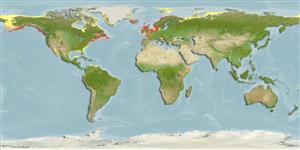Common names from other countries
Environment: milieu / climate zone / depth range / distribution range
экология
; пределы глубины 0 - 55 m (Ref. 83435). Temperate; 85°N - 15°N, 180°W - 39°E
Atlantic Ocean, Eastern Pacific , Arctic and the Mediterranean Sea. Subtropical to polar.
Length at first maturity / Size / Вес / Возраст
Maturity: Lm ? range ? - ? cm Max length : 2.0 cm TL самец/пол неопределен; (Ref. 822)
Assumed maximum length from Ref. 822. This species is found in infralittoral areas particularly in gulfs and estuaries. It is known as an omnivore, predator and a scavenger. It feeds on planktonic and minute detrital food items through either suspension or deposit feeding (Ref. 87872).
Life cycle and mating behavior
половая зрелость | размножение | нерест | икра | Fecundity | личинки
This species has separate sexes and are difficult to distinguish externally.
Основная ссылка
ссылки | координатор | соавторы
Turgeon, D.D., J.F. Quinn Jr., A.E. Bogan, E.V. Coan, F.G. Hochberg, W.G. Lyons, P.M. Mikkelsen, R.J. Neves, C.F.E. Roper, G. Rosenberg, B. Roth, A. Scheltema, F.G. Thompson, M. Vecchione and J.D. Willams. 1998. (Ref. 1667)
Статус Красного Списка МСОП (Ref. 130435)
Статус СИТЕС (Ref. 108899)
Not Evaluated
Not Evaluated
Использование человеком
| FishSource |
инструменты
дополнительная информация
ресурсы в Интернет
Estimates based on models
Preferred temperature
(Ref.
115969): 5.3 - 13.2, mean 9.6 (based on 636 cells).
Уязвимость
Low vulnerability (10 of 100).
Категория цены
Unknown.
